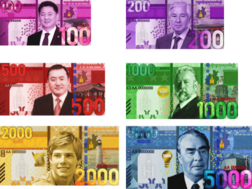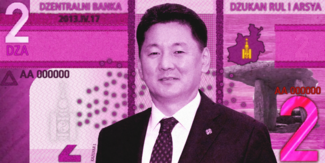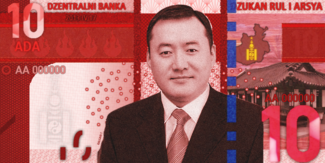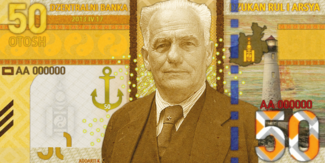Gabrielt Gabiro: Difference between revisions
Gabrielland (talk | contribs) |
Gabrielland (talk | contribs) mNo edit summary |
||
| Line 7: | Line 7: | ||
| issuing_authority = Central Bank of Gabrielland and Arsya | | issuing_authority = Central Bank of Gabrielland and Arsya | ||
| issuing_authority_website = | | issuing_authority_website = | ||
| date_of_introduction = 17 April 1926 - 1 January 2018 | | date_of_introduction = 17 April 1926 - 1 January 1977 <br> 1 March 1985 - 1 January 2018 | ||
| date_of_introduction_source = | | date_of_introduction_source = | ||
| using_countries = None (Formerly '''{{flag|Gabrielland}}''') | | using_countries = None (Formerly '''{{flag|Gabrielland}}''') | ||
| Line 31: | Line 31: | ||
| rarely_used_banknotes = 100 ɢ | | rarely_used_banknotes = 100 ɢ | ||
}} | }} | ||
The '''Gabiro''' (Gabrielt: Gabiro, IPA: ['gabiro], Arsyan: Kebbir, IPA: ['kebːɪr]) was the currency of [[Gabrielland]] between 1926 and 2018. The Gabrio was replaced by the [[Quasa]], the multinational currency of the [[Dokodo Union]]. The Gabiro was unique in which it was not a decimal currency, rather being divided into 16 Zaka and 320 Baziak. | The '''Gabiro''' (Gabrielt: Gabiro, IPA: ['gabiro], Arsyan: Kebbir, IPA: ['kebːɪr]) was the currency of [[Gabrielland]] between 1926 and 1977, and again from 1985 to 2018. The Gabrio was replaced by the [[Quasa]], the multinational currency of the [[Dokodo Union]]. The Gabiro was unique in which it was not a decimal currency, rather being divided into 16 Zaka and 320 Baziak. | ||
It was introduced in 1926 as the new currency of the recently formed union of Gabrielland and Arsya, replacing the Gabrielt Taga and the Arsyan Lirtta. The name ''Gabiro'' was agreed upon in the first parliamentary meeting of the union on the 19th of April 1926 as a combination of the Gabrielt word ''gaba'' meaning "money" and the Arsyan word ''kvirro'', also meaning money. | It was introduced in 1926 as the new currency of the recently formed union of Gabrielland and Arsya, replacing the Gabrielt Taga and the Arsyan Lirtta. The name ''Gabiro'' was agreed upon in the first parliamentary meeting of the union on the 19th of April 1926 as a combination of the Gabrielt word ''gaba'' meaning "money" and the Arsyan word ''kvirro'', also meaning money. In 1976, the Dzakwanist government abolished money, and the Gabrio ceased to become legal tender in Dzakwanist Gabrielland. It was kept as the official currency of the newly-formed Arsyan Republic until the 1st of January 1977 until it was replaced by the Arsyan Lirtta, which would become the currency until 1985 when it was once again replaced by the Gabiro. | ||
On the 1st of January 2018, the Gabiro was replaced by the Quasa at a rate of 0.28376 ɢ = 1 Q. Gabiro banknotes would still be able to be replaced until the 1st of January 2028 at par. | On the 1st of January 2018, the Gabiro was replaced by the Quasa at a rate of 0.28376 ɢ = 1 Q. Gabiro banknotes would still be able to be replaced until the 1st of January 2028 at par. | ||
| Line 64: | Line 64: | ||
! 5 | ! 5 | ||
| 19 February 1965 | | 19 February 1965 | ||
| 1 January | | 1 January 1977 | ||
|- | |- | ||
! 6 | ! 6 | ||
| 3 June | | 3 June 1973 | ||
| 1 January | | 1 January 1977 | ||
|- | |- | ||
! 7 | ! 7 | ||
| | | 1 May 1985 | ||
| 1 January 2004 | | 1 January 2004 | ||
|- | |- | ||
Revision as of 02:38, 11 May 2020
| Gabiro (Gabrielt) Kebbir (Arsyan) | |
|---|---|
 11th Gabiro Series (2013-2018) | |
| Unit | |
| Plural | Gabiri Kuhbbi |
| Symbol | ɢ |
| Denominations | |
| Subunit | |
| 1/16 | Zaka Zakka |
| 1/320 | Baziak Bzok |
| Plural | |
| Zaka Zakka | Zaki Zuhkki |
| Baziak Bzok | Baziaki Bzege |
| Symbol | |
| Zaka Zakka | z |
| Baziak Bzok | b |
| Banknotes | |
| Freq. used | 2, 5, 10, 20, 50 ɢ |
| Rarely used | 100 ɢ |
| Coins | |
| Freq. used | 2, 5, 10 b 1, 2, 4, 8 z 1 ɢ |
| Rarely used | 1 b 2 ɢ |
| Demographics | |
| Date of introduction | 17 April 1926 - 1 January 1977 1 March 1985 - 1 January 2018 |
| User(s) | None (Formerly |
| Issuance | |
| Central bank | Central Bank of Gabrielland and Arsya |
| Valuation | |
| Inflation | 1% |
The Gabiro (Gabrielt: Gabiro, IPA: ['gabiro], Arsyan: Kebbir, IPA: ['kebːɪr]) was the currency of Gabrielland between 1926 and 1977, and again from 1985 to 2018. The Gabrio was replaced by the Quasa, the multinational currency of the Dokodo Union. The Gabiro was unique in which it was not a decimal currency, rather being divided into 16 Zaka and 320 Baziak.
It was introduced in 1926 as the new currency of the recently formed union of Gabrielland and Arsya, replacing the Gabrielt Taga and the Arsyan Lirtta. The name Gabiro was agreed upon in the first parliamentary meeting of the union on the 19th of April 1926 as a combination of the Gabrielt word gaba meaning "money" and the Arsyan word kvirro, also meaning money. In 1976, the Dzakwanist government abolished money, and the Gabrio ceased to become legal tender in Dzakwanist Gabrielland. It was kept as the official currency of the newly-formed Arsyan Republic until the 1st of January 1977 until it was replaced by the Arsyan Lirtta, which would become the currency until 1985 when it was once again replaced by the Gabiro.
On the 1st of January 2018, the Gabiro was replaced by the Quasa at a rate of 0.28376 ɢ = 1 Q. Gabiro banknotes would still be able to be replaced until the 1st of January 2028 at par.
Banknotes
The Gabrielt Gabiro has seen several banknote series being released into general circulation. A total of 11 separate banknote families have been released between 1926 and 2018, with the latest series being released in 2013. Below is a list of banknote families released by the Central Bank of Gabrielland and Arsya and their withdrawal date.
| Series | Release | Withdrawal |
|---|---|---|
| 1 | 1 May 1926 | 1 January 1949 |
| 2 | 8 August - 17 September 1939 | 1 January 1964 |
| 3 | 11 May - 24 October 1954 | 1 January 1971 |
| 4 | 8 March 1961 | 1 January 1966 |
| 5 | 19 February 1965 | 1 January 1977 |
| 6 | 3 June 1973 | 1 January 1977 |
| 7 | 1 May 1985 | 1 January 2004 |
| 8 | 10 April 1994 | 1 January 2013 |
| 9 | 30 June 2003 | 1 January 2017 |
| 10 | 17 April 2007 | 1 January 2028 |
| 11 | 17 April 2013 | 1 January 2028 |
11th "Sontuvian" series (2013)
The 11th series of the Gabiro, more colloquiall known as the "Sontuvian" series after Finance Minister Gahttari Sontuvia, was first commissioned by the Central Bank of Gabrielland and Arsya around October of 2012, with a press report dated 15 October 2012 detailing the central bank's plan to further increase the safety and security of the Gabiro, as well as to keep the fresh look of the Gabiro. Overall, the general color scheme of the 11th series was kept the same, however with more stark and brighter colors to help differentiate between bills quicker. 4 of the 6 figures from the previous series were retained, with the 2 and 100 Gabiro being changed. The new banknotes featured more than 18 security features, which is a massive improvement from the previous series which had only basic features.
The 11th series has been criticized by many as being abnormally big, with the largest banknote, the 100 Gabiro, measuring more than 20 centimeters in length. Cost was also a major issue within the public space, after an annual report by the central bank declared that the banknotes were 3 times more expensive than the previous series. The central bank has claimed that these measures were necessary to combat the increasing amount of illegitimate bills circulating around Gabrielland.
The series maintains the denominations found in previous bill, and carries the imprint "2013-2017".
Coinage
These were the coins circulated before the adoption of the Quasa.
| Denomination | Obverse | Reverse | Value (Q) | Diameter (mm) | Thickness (mm) | Mass (g) | Composition | Edge | Latest Series | Withdrawn |
|---|---|---|---|---|---|---|---|---|---|---|
| Bzok (1b) | Valantas V | Emblem of Gabrielland | 0.0113 Q | 15.75 | 1.50 | 1.13 | Aluminum | Smooth | 2009 | 1 January 2028 |
| Ahkkahri II | Emblem of Arsya | 2007 | ||||||||
| Deers | Emblem of the New Frontier | 2014 | ||||||||
| Two Bzok (2b) | Valantas V | Emblem of Gabrielland | 0.0226 Q | 18.75 | 1.75 | 1.95g | 2008 | |||
| Ahkkari II | Emblem of Arsya | 2015 | ||||||||
| Cows | Emblem of the New Frontier | 2009 | ||||||||
| Fiver (5b) | Valkki Tahzimar | Emblem of Gabrielt State | 0.0565 Q | 23 | 2.10 | 2.87 | 1997 | |||
| Valantas V | Emblem of Gabrielland | 2009 | ||||||||
| Adayi (10b) | Valantas V | Emblem of Gabrielland | 0.113 Q | 22.55 | 2.15 | 3.4 | Copper plated steel | Milled | 2010 | |
| Ahkkari II | Emblem of Arsya | 2011 | ||||||||
| Tigers | Emblem of the New Frontier | 2015 | ||||||||
| Ahnimman Kazrul | Emblem of the Gabrielt State | 1997 | ||||||||
| Zaka (1z) | Valantas V | Emblem of Gabrielland | 0.226 Q | 25.15 | 2.45 | 4.45 | 2010 | |||
| Ahkarri II | Emblem of Arsya | 2008 | ||||||||
| Eagles | Emblem of the New Frontier | 2014 | ||||||||
| Eighter (2z) | Valantas V | Gabrielt Tazmak | 0.452 Q | 28.05 | 2.65 | 6.15 | Nordic gold | Fine Scallops | 2015 | |
| Ahkkari II | Emblem of Arsya | 2013 | ||||||||
| Falcons | Emblem of the New Frontier | 2014 | ||||||||
| Marak (4z) | Valantas V | Gabrielt Tazmak | 0.904 Q | 31.65 | 2.85 | 8.35 | 2015 | |||
| Ahkkari II | Emblem of Arsya | 2013 | ||||||||
| Monkeys | Emblem of the New Frontier | 2014 | ||||||||
| Halver (8z) | Valantas V | Gabrielt Tazmak | 1.808 Q | 31.65 | 3.05 | 9.65 | Bimetallic; Outer: Nordic gold Inner: Cupronickel |
Fine Milled | 2011 | |
| Ahkkari II | Emblem of Arsya | 2012 | ||||||||
| Gabiro (1ɢ) | Valantas V | Gabrielt Tazmak | 3.616 Q | 33.55 | 3.35 | 11.45 | Bimetallic; Outer: Nordic gold Inner: Nickel-Brass |
2013 | ||
| Ahkkari II | Emblem of Arsya | 2010 | ||||||||
| Double (2ɢ) | Valantas V | Gabrielt Tazmak | 7.232 Q | 37.15 | 3.65 | 14.55 | Trimetallic; Outer: Nordic gold Middle: Manganese bronze Inner: Cupro-Nickel |
Fine Milled, Edge Lettering | 2015 | |
| Ahkkari II | Emblem of Arsya | 2014 |





